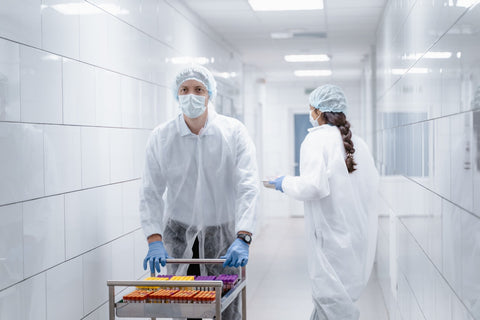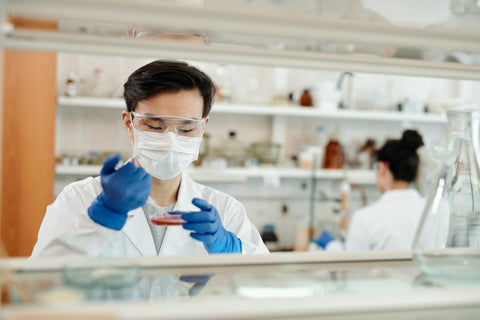Everything you need to know about the PPE Worn During Microbial Collection
Which PPE should you wear During Microbial Collection

PPE is widely used in various industries as a preventive measure. It helps in protecting the workforce from industrial hazards. The more the risk level, the more the protection PPE must ensure. The microbial collection is an activity that is performed in specialty labs, primarily for research purposes. It is considered a high-risk activity because it directly interacts with the microbes. So, the PPE worn during the activity should ensure the wearer’s protection. In this article, we will be discussing different PPEs that should be donned while doing the microbial collection.
What is a microbial collection? Why is it done?
Collections are a way to keep track of valuables. What is valuable? For someone, it may be modern art, and for others, it may be bottle caps. Irrespective of the definition of valuables, collectors are distinguished from hoarders. It is due to the purpose of the collection, which is the interest. The microbial collection is a repository of microbes collected for research purposes. The intention behind this repository is to study microbial life. It involves three basic steps, namely deposition, storage, and retrieval.

The microbial collection serves the purpose of aiding the research community with the repository of microbes. As it is classified under scientific collection, deposition, storage, and maintenance are the tedious task that demands the involvement of skilled professionals. This microbial repository plays a vital role in the fields of microbiology, healthcare, medicines, and agriculture. If you are interested to know more, then check out this article on microbial collection.
Which PPE is recommended for microbial collection?
PPE that is recommended here refers to protective gear, which excludes clothing that protects the wearer from weather conditions. It means caps, hats, sports shoes, sunglasses, sunscreen, and uniforms are not considered PPE. Washing hands with soap & water, use of hand sanitizers, spraying disinfectants, and other related practices are not considered PPE. When you choose the right PPE, then it can protect one from pathogens.

PPE acts as a barrier between the human body & pathogens, thus denying any direct interaction. Moreover, it also blocks any chances of transmission of pathogens from the wearer to the surroundings. In short, PPE is recommended for microbial collection activity for the protection of the wearer from any pathogenic infection. Organizations like WHO & CDC recommend PPE in various settings. Let’s discuss different types of PPE for microbial collection.
You can also check out our blog on PPE for phlebotomy.
PPE for Head Protection
There is no need to wear any helmet or other head protection PPE. It is recommended that one should wear a head cover (also called a hair cover). It reduces any chance of contamination, while the microbial collection as well as protects the wearer from any pathogenic interaction.
PPE for Respiratory Protection

Face masks & respirators have become quite popular, thanks to the COVID-19 pandemic. This respiratory protection PPE is worn by the wearer to eliminate any chance of inhaling the microbes. Respiratory protection PPE type is decided based on the pathogenic level. For pathogens, N95 respirators are highly recommended. In some cases, special types of masks such as cartridge type masks, gas masks, SCBA (self-contained breathing apparatus), and many others. When the microbes are not pathogenic, surgical face masks are preferred. CDC & BMBL (Biosafety in Microbiological and Biomedical Laboratories) issues the guidance on the type of respiratory protection PPE one should don when dealing with specific agents.
PPE for Hand Protection

Hand protection is quite vital in microbial collection activity for the prevention of the transmission of microbes. During the microbial collection activity, the hands are the most human part as they perform the most tasks during the activity. So, the hand protection PPE should not compromise the dexterity too. Hand gloves are the most sought PPE for hand protection. Primarily, there are three types of gloves used in lab settings. Sterile gloves are disposal ones used for invasive tasks. Non-sterile gloves are single-use disposable ones used for protection against fluids. Heavy-duty gloves are reusable gloves. For microbial collection activity, disposable gendine antimicrobial gloves are recommended. They reduce the microbial transmission rate.
PPE for Foot Protection
Safety shoes (or even closed shoes are fine) are preferred in most cases for microbial collection. Shoe covers are highly recommended. Foot protection PPE is vital to prevent microbial transmission.
PPE for Face Protection
Face shields are used while microbial collection if dealing with highly pathogenic microbes.
PPE for Eye Protection

The human eyes are one of the most sensitive parts. Based on the risk factor of the microbial collection, which is based on the microbes collected, one may require to wear eye protection PPE. This PPE is usually safety goggles or safety glasses. They protect the wearer by acting as a shield between the eyes & the microbes.
PPE for Ear Protection
While there is no specific need for any PPE for ear protection, it is recommended that one may wear earbuds to prevent even the slimmest chance of transmission.
PPE for Body Protection

The microbial collection is a risky activity if the microbe is pathogenic. It becomes vital to prevent direct interaction between the human body (especially the skin) & microbes. Depending upon the severity of the microbial hazard, one can don lab coats, PPE gowns (or aprons), and special PPE body suits. Lab coats are reusable after disinfection, while PPE gowns are single-use & disposable. Special PPE suits like the positive pressure PPE body suits are used to isolate the wearer from the surrounding conditions while microbial collection. These PPE body suits are connected to a separately attached airline fitted with a HEPA filter. The wearer of such special PPE body suits needs to undergo PPE training.
Curious ones can check out our blog on PPE protection.
Any other recommendation apart from PPE?
- If you have long hair, then it must be tied back.
- One must wear full pants that would cover even the ankles. Shorter pants (which don’t cover the ankles) and skirts are prohibited.
- Shirts that completely cover skin should be worn. They should also completely cover one’s torso.
Conclusion

The microbial collection is considered a high-risk activity as it deals with microbes that may be pathogenic in nature. As there is a direct interaction between microbes, PPE donned must ensure the protection of the wearer. In this article, we have mentioned all the types of PPE that one should consider wearing. Stay healthy! Stay safe!
